Comprehensive Use Case Report: Travel Swipe Card Transaction System
VerifiedAdded on 2020/03/13
|10
|1469
|116
Report
AI Summary
This report presents a comprehensive use case analysis of a travel swipe card transaction system. It begins with an overview of use case diagrams, their components, and objectives within the context of system analysis. The report then delves into the specifics of a travel swipe card system, detailing the 'Card Swipe In' and 'Card Swipe Out' use cases. Each use case includes diagrams, descriptions of actor interactions, and system processes such as card validation, balance checks, and fare calculations. The 'Card Swipe Out' use case is described in detail, including system name, use case ID, description of normal flow, preconditions, postconditions, exceptions, and special requirements like GPS and programming considerations. The report concludes with a list of references, including relevant research papers and patents related to electronic ticketing and payment systems.
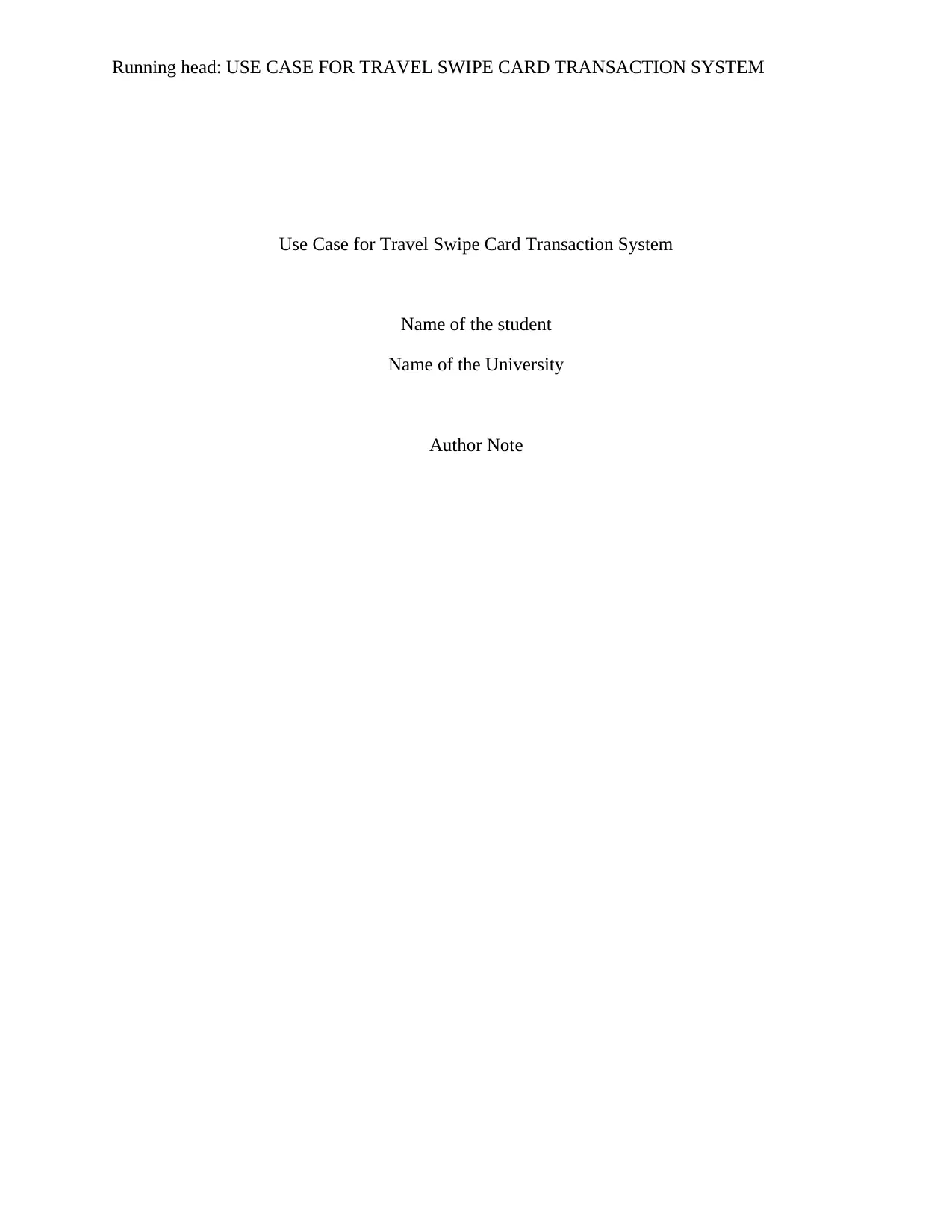
Running head: USE CASE FOR TRAVEL SWIPE CARD TRANSACTION SYSTEM
Use Case for Travel Swipe Card Transaction System
Name of the student
Name of the University
Author Note
Use Case for Travel Swipe Card Transaction System
Name of the student
Name of the University
Author Note
Secure Best Marks with AI Grader
Need help grading? Try our AI Grader for instant feedback on your assignments.
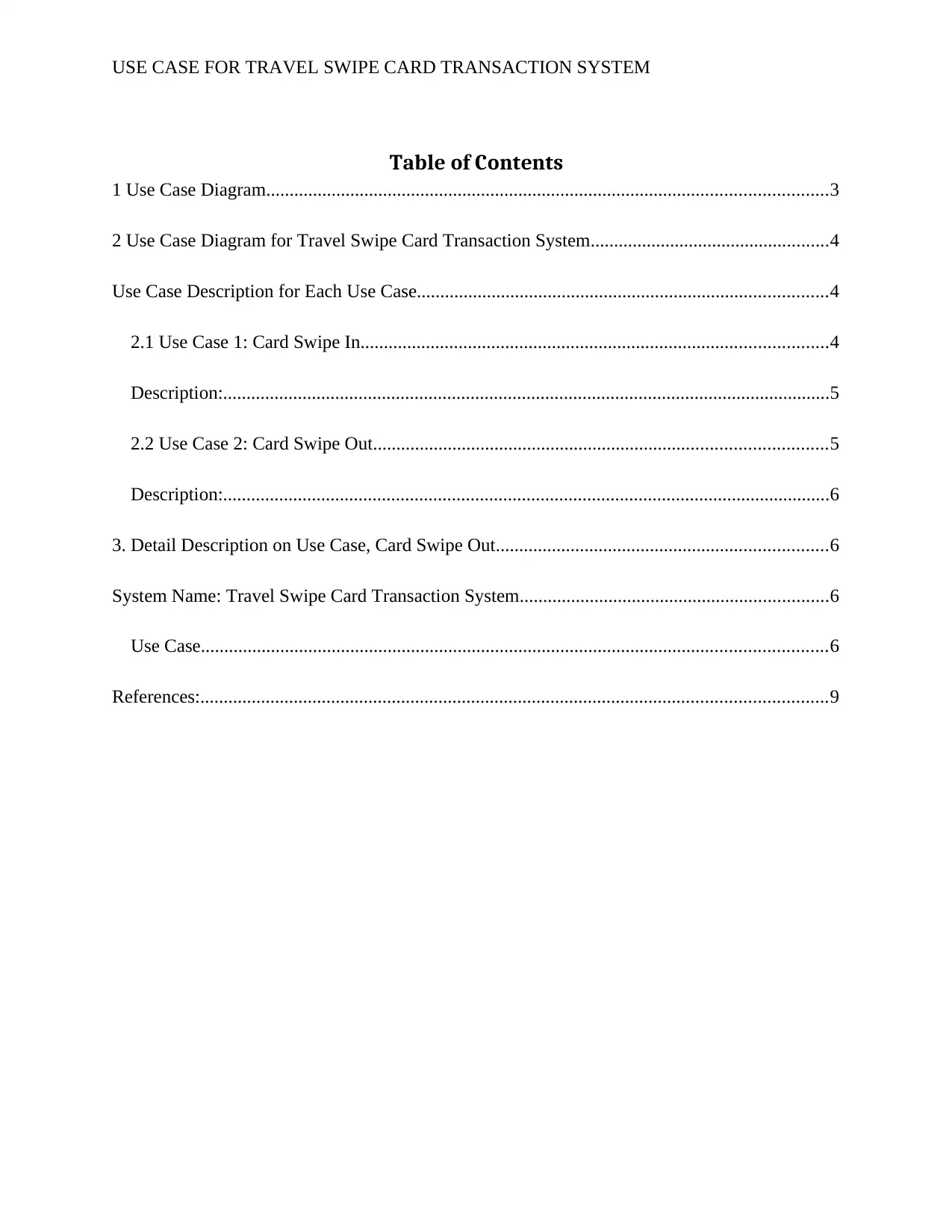
USE CASE FOR TRAVEL SWIPE CARD TRANSACTION SYSTEM
Table of Contents
1 Use Case Diagram........................................................................................................................3
2 Use Case Diagram for Travel Swipe Card Transaction System...................................................4
Use Case Description for Each Use Case........................................................................................4
2.1 Use Case 1: Card Swipe In....................................................................................................4
Description:..................................................................................................................................5
2.2 Use Case 2: Card Swipe Out.................................................................................................5
Description:..................................................................................................................................6
3. Detail Description on Use Case, Card Swipe Out.......................................................................6
System Name: Travel Swipe Card Transaction System..................................................................6
Use Case......................................................................................................................................6
References:......................................................................................................................................9
Table of Contents
1 Use Case Diagram........................................................................................................................3
2 Use Case Diagram for Travel Swipe Card Transaction System...................................................4
Use Case Description for Each Use Case........................................................................................4
2.1 Use Case 1: Card Swipe In....................................................................................................4
Description:..................................................................................................................................5
2.2 Use Case 2: Card Swipe Out.................................................................................................5
Description:..................................................................................................................................6
3. Detail Description on Use Case, Card Swipe Out.......................................................................6
System Name: Travel Swipe Card Transaction System..................................................................6
Use Case......................................................................................................................................6
References:......................................................................................................................................9
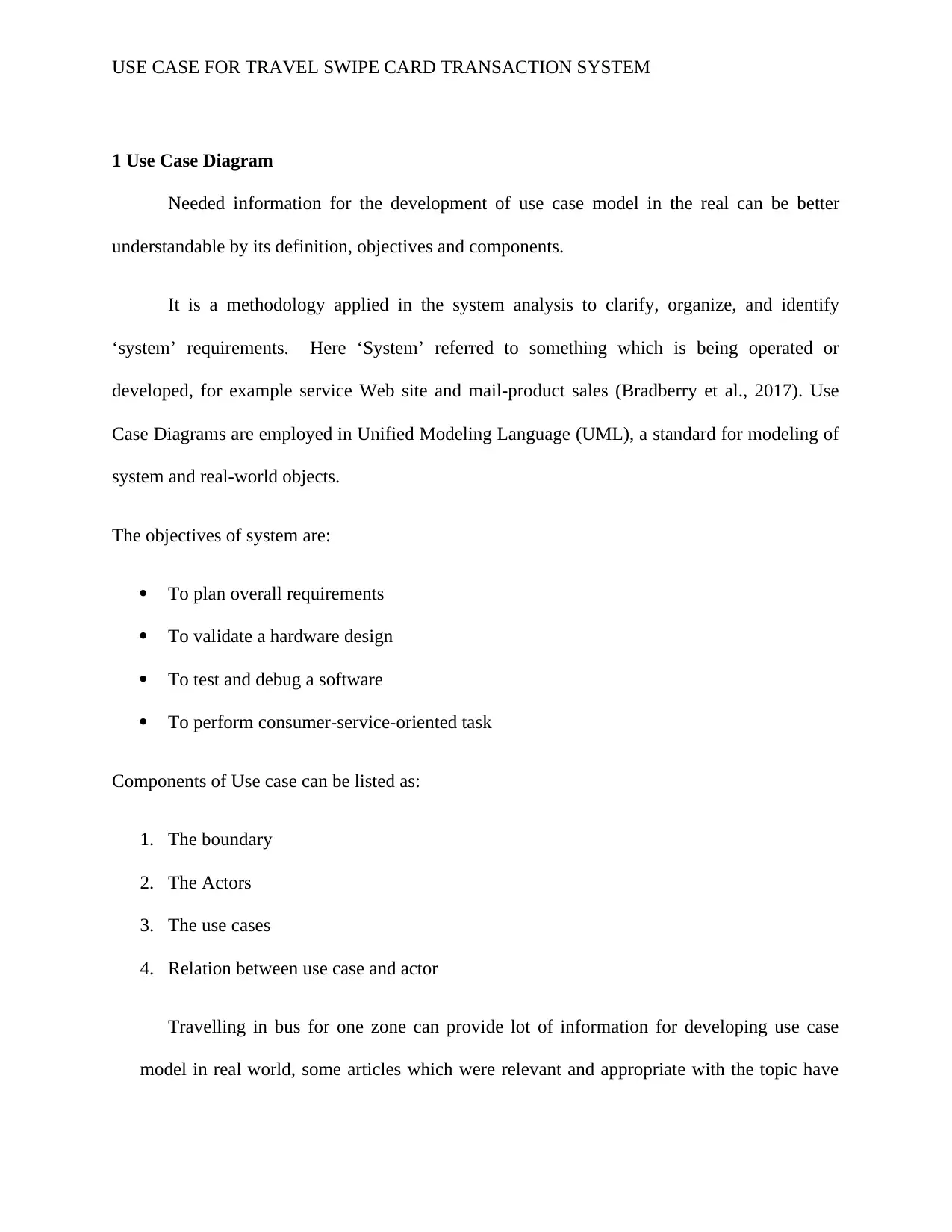
USE CASE FOR TRAVEL SWIPE CARD TRANSACTION SYSTEM
1 Use Case Diagram
Needed information for the development of use case model in the real can be better
understandable by its definition, objectives and components.
It is a methodology applied in the system analysis to clarify, organize, and identify
‘system’ requirements. Here ‘System’ referred to something which is being operated or
developed, for example service Web site and mail-product sales (Bradberry et al., 2017). Use
Case Diagrams are employed in Unified Modeling Language (UML), a standard for modeling of
system and real-world objects.
The objectives of system are:
To plan overall requirements
To validate a hardware design
To test and debug a software
To perform consumer-service-oriented task
Components of Use case can be listed as:
1. The boundary
2. The Actors
3. The use cases
4. Relation between use case and actor
Travelling in bus for one zone can provide lot of information for developing use case
model in real world, some articles which were relevant and appropriate with the topic have
1 Use Case Diagram
Needed information for the development of use case model in the real can be better
understandable by its definition, objectives and components.
It is a methodology applied in the system analysis to clarify, organize, and identify
‘system’ requirements. Here ‘System’ referred to something which is being operated or
developed, for example service Web site and mail-product sales (Bradberry et al., 2017). Use
Case Diagrams are employed in Unified Modeling Language (UML), a standard for modeling of
system and real-world objects.
The objectives of system are:
To plan overall requirements
To validate a hardware design
To test and debug a software
To perform consumer-service-oriented task
Components of Use case can be listed as:
1. The boundary
2. The Actors
3. The use cases
4. Relation between use case and actor
Travelling in bus for one zone can provide lot of information for developing use case
model in real world, some articles which were relevant and appropriate with the topic have
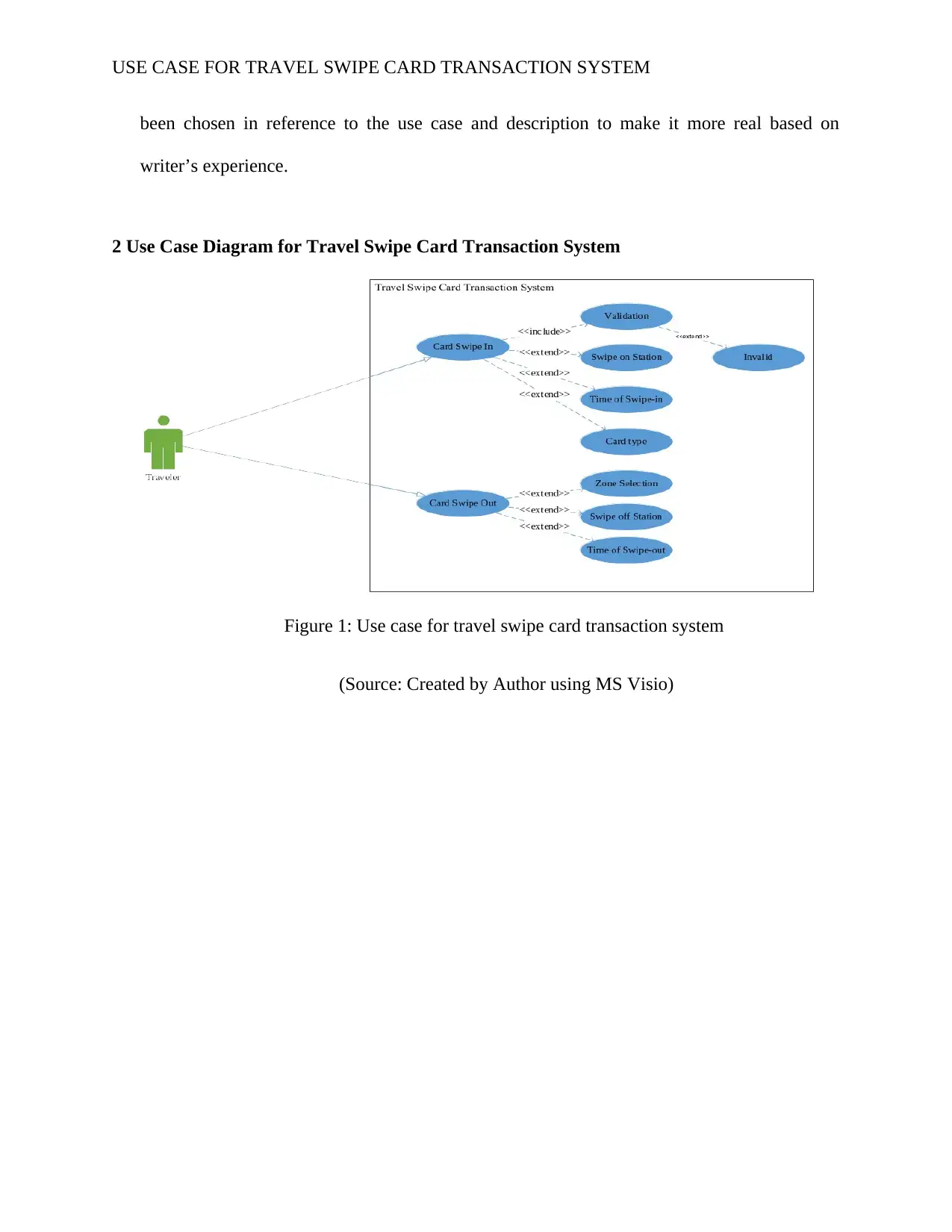
USE CASE FOR TRAVEL SWIPE CARD TRANSACTION SYSTEM
been chosen in reference to the use case and description to make it more real based on
writer’s experience.
2 Use Case Diagram for Travel Swipe Card Transaction System
Figure 1: Use case for travel swipe card transaction system
(Source: Created by Author using MS Visio)
been chosen in reference to the use case and description to make it more real based on
writer’s experience.
2 Use Case Diagram for Travel Swipe Card Transaction System
Figure 1: Use case for travel swipe card transaction system
(Source: Created by Author using MS Visio)
Secure Best Marks with AI Grader
Need help grading? Try our AI Grader for instant feedback on your assignments.
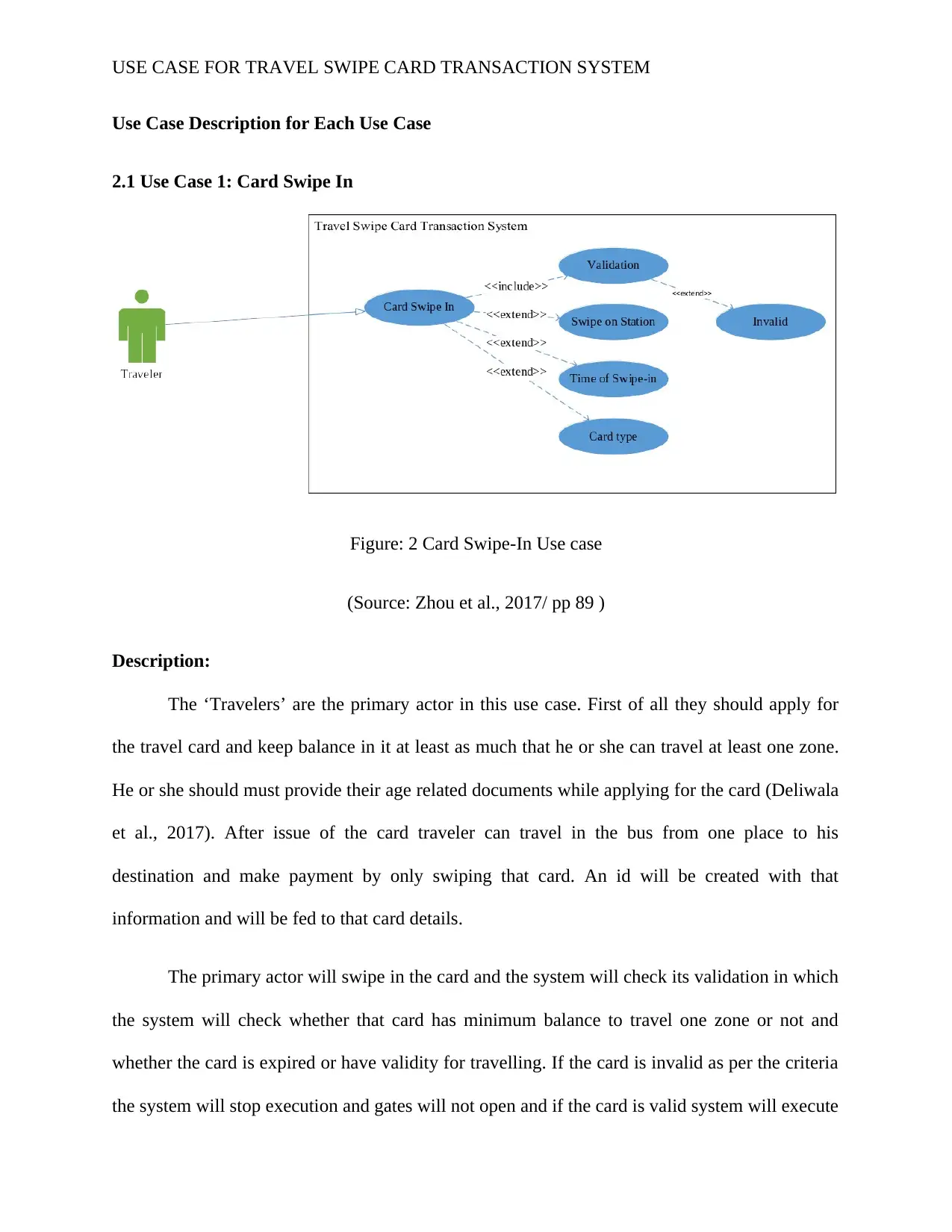
USE CASE FOR TRAVEL SWIPE CARD TRANSACTION SYSTEM
Use Case Description for Each Use Case
2.1 Use Case 1: Card Swipe In
Figure: 2 Card Swipe-In Use case
(Source: Zhou et al., 2017/ pp 89 )
Description:
The ‘Travelers’ are the primary actor in this use case. First of all they should apply for
the travel card and keep balance in it at least as much that he or she can travel at least one zone.
He or she should must provide their age related documents while applying for the card (Deliwala
et al., 2017). After issue of the card traveler can travel in the bus from one place to his
destination and make payment by only swiping that card. An id will be created with that
information and will be fed to that card details.
The primary actor will swipe in the card and the system will check its validation in which
the system will check whether that card has minimum balance to travel one zone or not and
whether the card is expired or have validity for travelling. If the card is invalid as per the criteria
the system will stop execution and gates will not open and if the card is valid system will execute
Use Case Description for Each Use Case
2.1 Use Case 1: Card Swipe In
Figure: 2 Card Swipe-In Use case
(Source: Zhou et al., 2017/ pp 89 )
Description:
The ‘Travelers’ are the primary actor in this use case. First of all they should apply for
the travel card and keep balance in it at least as much that he or she can travel at least one zone.
He or she should must provide their age related documents while applying for the card (Deliwala
et al., 2017). After issue of the card traveler can travel in the bus from one place to his
destination and make payment by only swiping that card. An id will be created with that
information and will be fed to that card details.
The primary actor will swipe in the card and the system will check its validation in which
the system will check whether that card has minimum balance to travel one zone or not and
whether the card is expired or have validity for travelling. If the card is invalid as per the criteria
the system will stop execution and gates will not open and if the card is valid system will execute
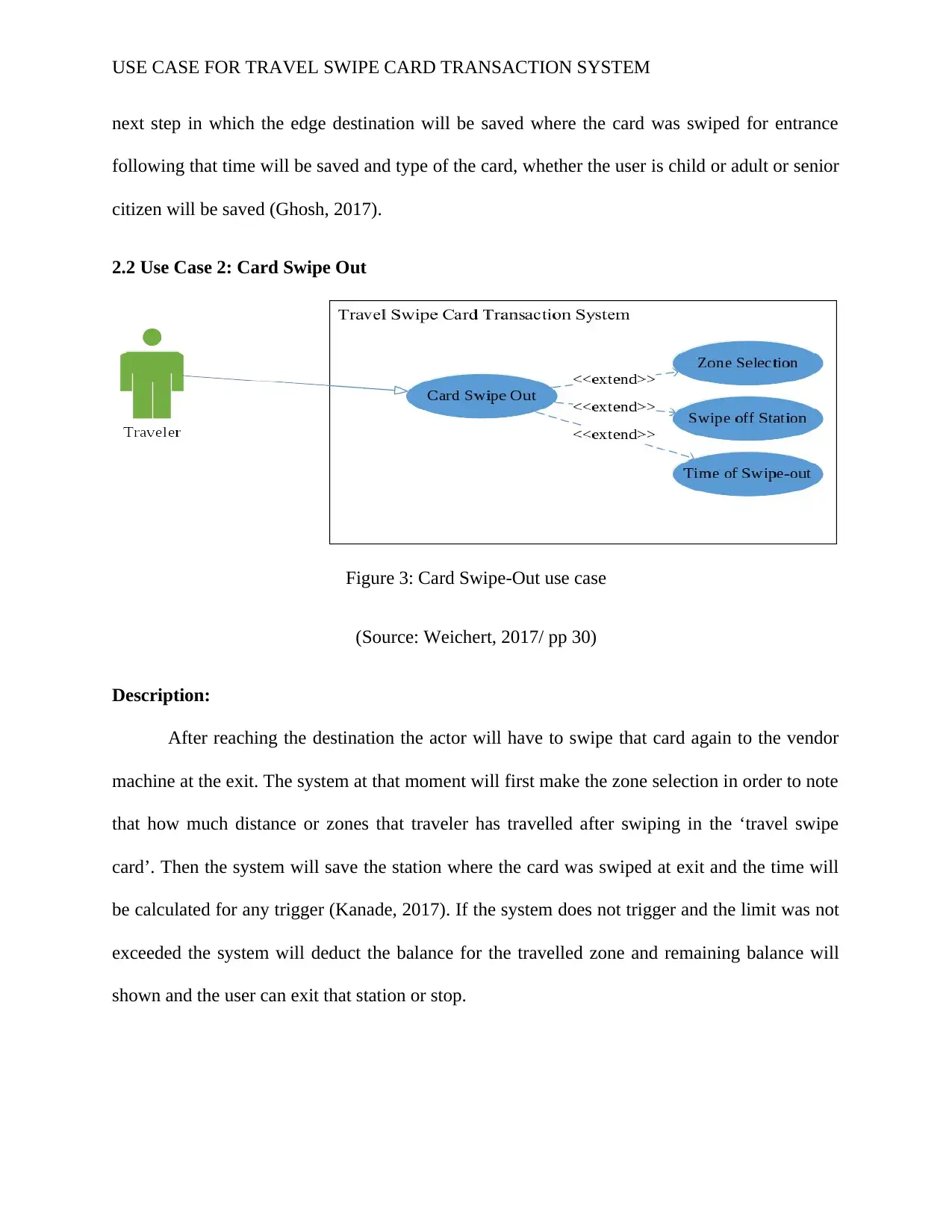
USE CASE FOR TRAVEL SWIPE CARD TRANSACTION SYSTEM
next step in which the edge destination will be saved where the card was swiped for entrance
following that time will be saved and type of the card, whether the user is child or adult or senior
citizen will be saved (Ghosh, 2017).
2.2 Use Case 2: Card Swipe Out
Figure 3: Card Swipe-Out use case
(Source: Weichert, 2017/ pp 30)
Description:
After reaching the destination the actor will have to swipe that card again to the vendor
machine at the exit. The system at that moment will first make the zone selection in order to note
that how much distance or zones that traveler has travelled after swiping in the ‘travel swipe
card’. Then the system will save the station where the card was swiped at exit and the time will
be calculated for any trigger (Kanade, 2017). If the system does not trigger and the limit was not
exceeded the system will deduct the balance for the travelled zone and remaining balance will
shown and the user can exit that station or stop.
next step in which the edge destination will be saved where the card was swiped for entrance
following that time will be saved and type of the card, whether the user is child or adult or senior
citizen will be saved (Ghosh, 2017).
2.2 Use Case 2: Card Swipe Out
Figure 3: Card Swipe-Out use case
(Source: Weichert, 2017/ pp 30)
Description:
After reaching the destination the actor will have to swipe that card again to the vendor
machine at the exit. The system at that moment will first make the zone selection in order to note
that how much distance or zones that traveler has travelled after swiping in the ‘travel swipe
card’. Then the system will save the station where the card was swiped at exit and the time will
be calculated for any trigger (Kanade, 2017). If the system does not trigger and the limit was not
exceeded the system will deduct the balance for the travelled zone and remaining balance will
shown and the user can exit that station or stop.
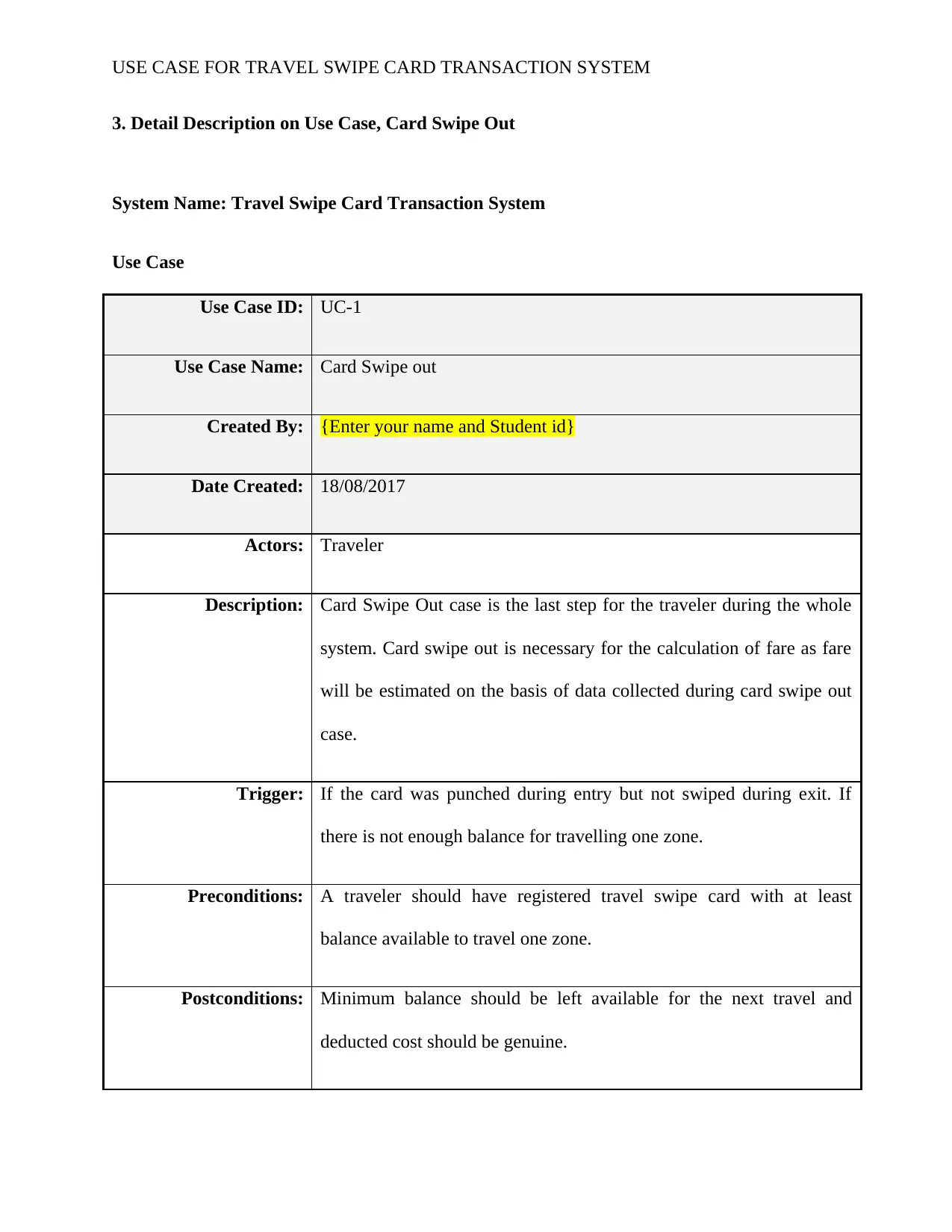
USE CASE FOR TRAVEL SWIPE CARD TRANSACTION SYSTEM
3. Detail Description on Use Case, Card Swipe Out
System Name: Travel Swipe Card Transaction System
Use Case
Use Case ID: UC-1
Use Case Name: Card Swipe out
Created By: {Enter your name and Student id}
Date Created: 18/08/2017
Actors: Traveler
Description: Card Swipe Out case is the last step for the traveler during the whole
system. Card swipe out is necessary for the calculation of fare as fare
will be estimated on the basis of data collected during card swipe out
case.
Trigger: If the card was punched during entry but not swiped during exit. If
there is not enough balance for travelling one zone.
Preconditions: A traveler should have registered travel swipe card with at least
balance available to travel one zone.
Postconditions: Minimum balance should be left available for the next travel and
deducted cost should be genuine.
3. Detail Description on Use Case, Card Swipe Out
System Name: Travel Swipe Card Transaction System
Use Case
Use Case ID: UC-1
Use Case Name: Card Swipe out
Created By: {Enter your name and Student id}
Date Created: 18/08/2017
Actors: Traveler
Description: Card Swipe Out case is the last step for the traveler during the whole
system. Card swipe out is necessary for the calculation of fare as fare
will be estimated on the basis of data collected during card swipe out
case.
Trigger: If the card was punched during entry but not swiped during exit. If
there is not enough balance for travelling one zone.
Preconditions: A traveler should have registered travel swipe card with at least
balance available to travel one zone.
Postconditions: Minimum balance should be left available for the next travel and
deducted cost should be genuine.
Paraphrase This Document
Need a fresh take? Get an instant paraphrase of this document with our AI Paraphraser
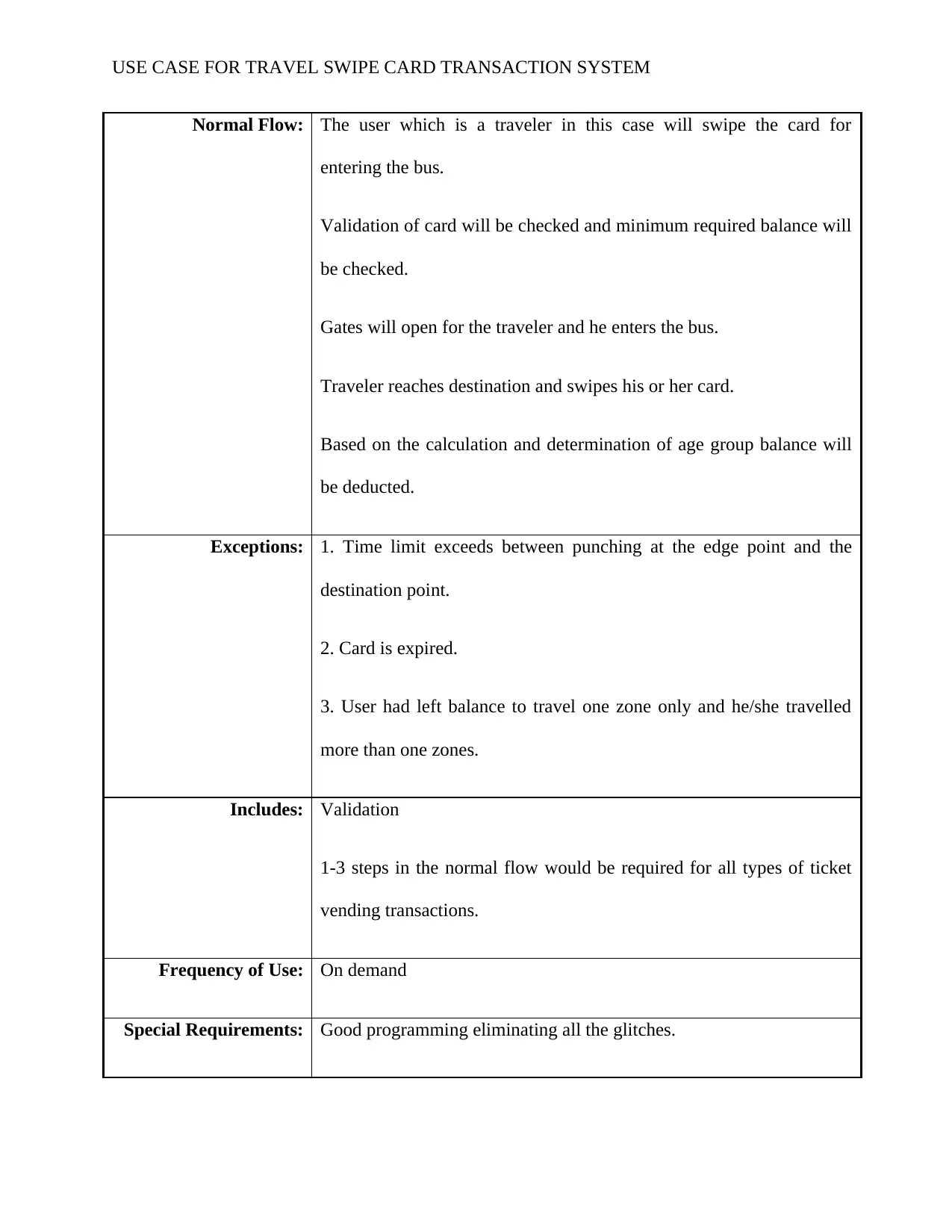
USE CASE FOR TRAVEL SWIPE CARD TRANSACTION SYSTEM
Normal Flow: The user which is a traveler in this case will swipe the card for
entering the bus.
Validation of card will be checked and minimum required balance will
be checked.
Gates will open for the traveler and he enters the bus.
Traveler reaches destination and swipes his or her card.
Based on the calculation and determination of age group balance will
be deducted.
Exceptions: 1. Time limit exceeds between punching at the edge point and the
destination point.
2. Card is expired.
3. User had left balance to travel one zone only and he/she travelled
more than one zones.
Includes: Validation
1-3 steps in the normal flow would be required for all types of ticket
vending transactions.
Frequency of Use: On demand
Special Requirements: Good programming eliminating all the glitches.
Normal Flow: The user which is a traveler in this case will swipe the card for
entering the bus.
Validation of card will be checked and minimum required balance will
be checked.
Gates will open for the traveler and he enters the bus.
Traveler reaches destination and swipes his or her card.
Based on the calculation and determination of age group balance will
be deducted.
Exceptions: 1. Time limit exceeds between punching at the edge point and the
destination point.
2. Card is expired.
3. User had left balance to travel one zone only and he/she travelled
more than one zones.
Includes: Validation
1-3 steps in the normal flow would be required for all types of ticket
vending transactions.
Frequency of Use: On demand
Special Requirements: Good programming eliminating all the glitches.
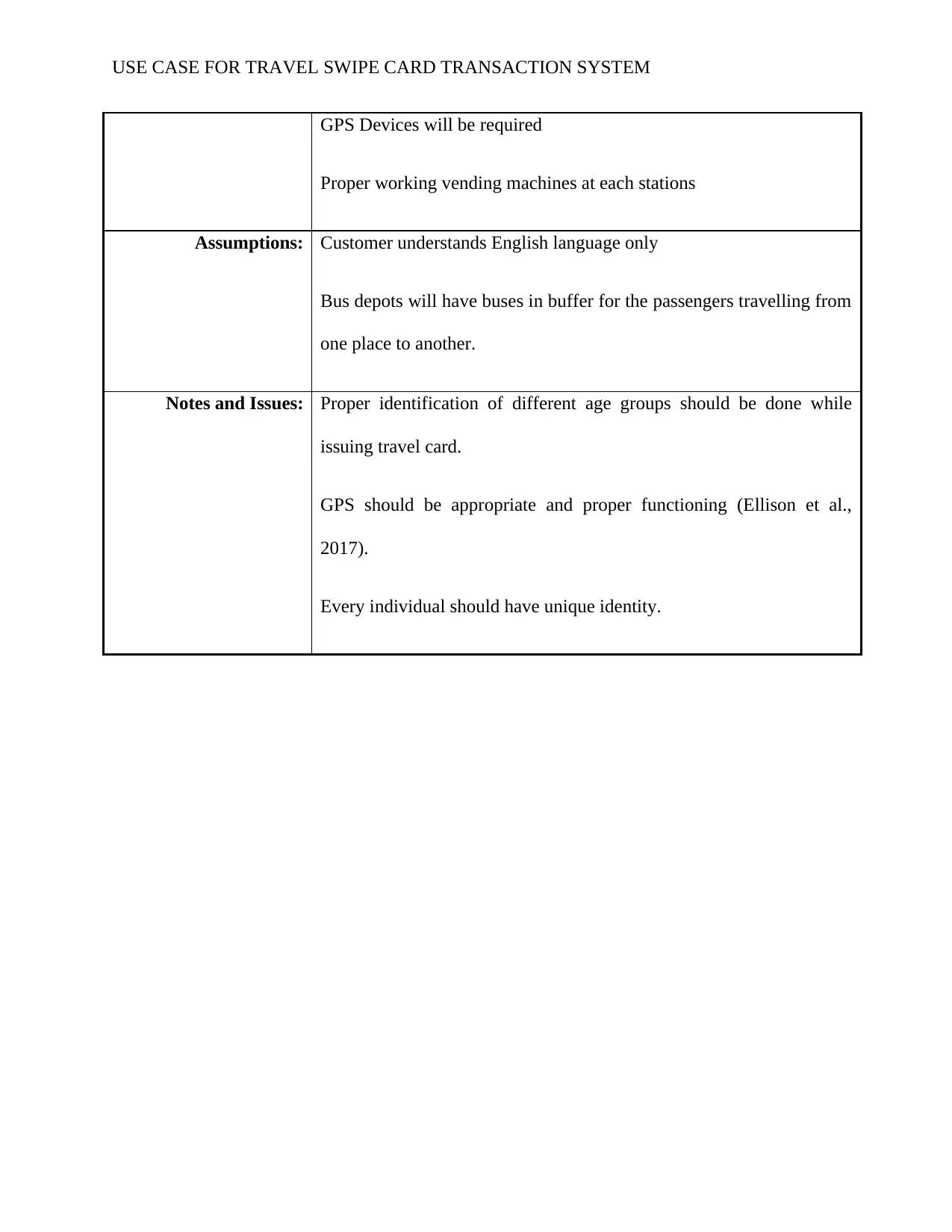
USE CASE FOR TRAVEL SWIPE CARD TRANSACTION SYSTEM
GPS Devices will be required
Proper working vending machines at each stations
Assumptions: Customer understands English language only
Bus depots will have buses in buffer for the passengers travelling from
one place to another.
Notes and Issues: Proper identification of different age groups should be done while
issuing travel card.
GPS should be appropriate and proper functioning (Ellison et al.,
2017).
Every individual should have unique identity.
GPS Devices will be required
Proper working vending machines at each stations
Assumptions: Customer understands English language only
Bus depots will have buses in buffer for the passengers travelling from
one place to another.
Notes and Issues: Proper identification of different age groups should be done while
issuing travel card.
GPS should be appropriate and proper functioning (Ellison et al.,
2017).
Every individual should have unique identity.
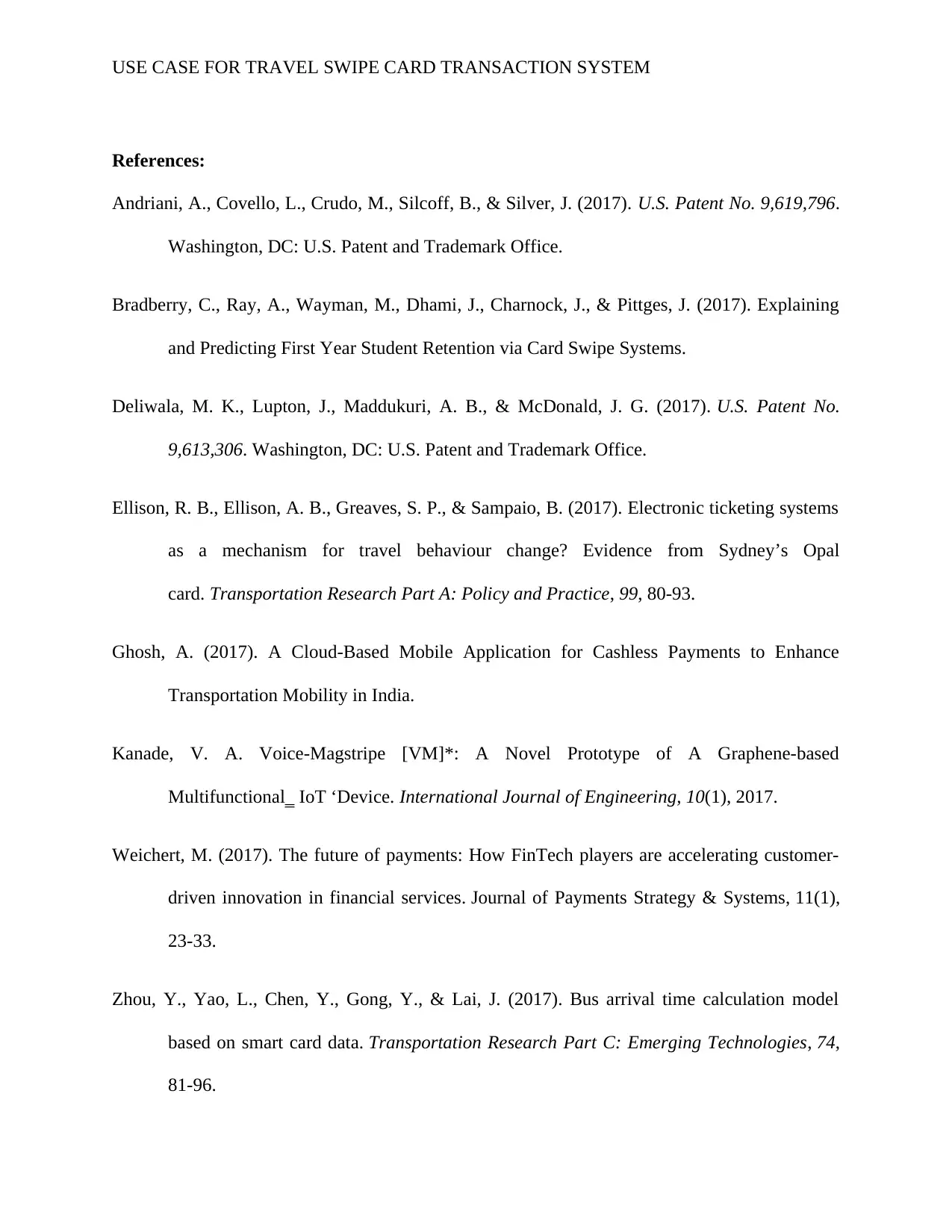
USE CASE FOR TRAVEL SWIPE CARD TRANSACTION SYSTEM
References:
Andriani, A., Covello, L., Crudo, M., Silcoff, B., & Silver, J. (2017). U.S. Patent No. 9,619,796.
Washington, DC: U.S. Patent and Trademark Office.
Bradberry, C., Ray, A., Wayman, M., Dhami, J., Charnock, J., & Pittges, J. (2017). Explaining
and Predicting First Year Student Retention via Card Swipe Systems.
Deliwala, M. K., Lupton, J., Maddukuri, A. B., & McDonald, J. G. (2017). U.S. Patent No.
9,613,306. Washington, DC: U.S. Patent and Trademark Office.
Ellison, R. B., Ellison, A. B., Greaves, S. P., & Sampaio, B. (2017). Electronic ticketing systems
as a mechanism for travel behaviour change? Evidence from Sydney’s Opal
card. Transportation Research Part A: Policy and Practice, 99, 80-93.
Ghosh, A. (2017). A Cloud-Based Mobile Application for Cashless Payments to Enhance
Transportation Mobility in India.
Kanade, V. A. Voice-Magstripe [VM]*: A Novel Prototype of A Graphene-based
Multifunctional‗ IoT ‘Device. International Journal of Engineering, 10(1), 2017.
Weichert, M. (2017). The future of payments: How FinTech players are accelerating customer-
driven innovation in financial services. Journal of Payments Strategy & Systems, 11(1),
23-33.
Zhou, Y., Yao, L., Chen, Y., Gong, Y., & Lai, J. (2017). Bus arrival time calculation model
based on smart card data. Transportation Research Part C: Emerging Technologies, 74,
81-96.
References:
Andriani, A., Covello, L., Crudo, M., Silcoff, B., & Silver, J. (2017). U.S. Patent No. 9,619,796.
Washington, DC: U.S. Patent and Trademark Office.
Bradberry, C., Ray, A., Wayman, M., Dhami, J., Charnock, J., & Pittges, J. (2017). Explaining
and Predicting First Year Student Retention via Card Swipe Systems.
Deliwala, M. K., Lupton, J., Maddukuri, A. B., & McDonald, J. G. (2017). U.S. Patent No.
9,613,306. Washington, DC: U.S. Patent and Trademark Office.
Ellison, R. B., Ellison, A. B., Greaves, S. P., & Sampaio, B. (2017). Electronic ticketing systems
as a mechanism for travel behaviour change? Evidence from Sydney’s Opal
card. Transportation Research Part A: Policy and Practice, 99, 80-93.
Ghosh, A. (2017). A Cloud-Based Mobile Application for Cashless Payments to Enhance
Transportation Mobility in India.
Kanade, V. A. Voice-Magstripe [VM]*: A Novel Prototype of A Graphene-based
Multifunctional‗ IoT ‘Device. International Journal of Engineering, 10(1), 2017.
Weichert, M. (2017). The future of payments: How FinTech players are accelerating customer-
driven innovation in financial services. Journal of Payments Strategy & Systems, 11(1),
23-33.
Zhou, Y., Yao, L., Chen, Y., Gong, Y., & Lai, J. (2017). Bus arrival time calculation model
based on smart card data. Transportation Research Part C: Emerging Technologies, 74,
81-96.
1 out of 10
Related Documents
Your All-in-One AI-Powered Toolkit for Academic Success.
+13062052269
info@desklib.com
Available 24*7 on WhatsApp / Email
![[object Object]](/_next/static/media/star-bottom.7253800d.svg)
Unlock your academic potential
© 2024 | Zucol Services PVT LTD | All rights reserved.





